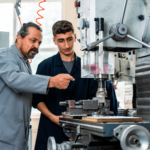The one-size-fits-all approach has long been recognised as inadequate in education and professional development. Today’s learners come from diverse backgrounds, have varied skill sets, and exhibit distinct learning preferences. Consequently, there’s been a growing necessity to cater to individual learning needs more effectively. Using technology to create personalised learning paths has become a key element in achieving this goal. Personalised learning paths offer learners adaptive experiences tailored to their unique characteristics, preferences, and aspirations, significantly enhancing their engagement and outcomes.
Personalised learning paths utilise data analytics, artificial intelligence (AI), and machine learning to provide an individualised learning journey. Through technology, learners receive content and learning activities that align with their pace, style, and areas of interest. This tailored approach maximises learning efficiency and encourages a more engaging and fulfilling educational experience.
Benefits of Personalised Learning Paths
Personalised learning paths offer myriad benefits that enhance learning and student outcomes. One key advantage is enhanced engagement. Adaptive content is tailored to the learner’s progress, ensuring the material remains relevant and appropriately challenging. This adaptation prevents boredom or frustration that can arise when content is too easy or too difficult. Additionally, interactive features such as gamification, simulations, and interactive modules significantly contribute to keeping learners engaged, making the educational experience more enjoyable and immersive.
Another significant benefit of personalised learning paths is improved information retention. These paths can incorporate techniques like spaced repetition, which helps reinforce learning over time and enhances long-term retention. Furthermore, contextual learning ensures that the content is relevant to the learner’s specific situation, making it easier to apply and recall the knowledge in practical scenarios.
Personalised learning paths also markedly improve learning efficiency. Learners can progress at their own pace, allowing them to spend more time on challenging areas and swiftly move through topics they are already familiar with. This self-paced approach ensures that time is used efficiently, as learners can focus on areas that need improvement rather than spending unnecessary time on redundant topics. Personalised learning paths create a more effective, engaging, and efficient learning experience tailored to individual needs and progress.

Tools and Technologies Enabling Personalisation
Personalised learning paths have revolutionised the educational landscape, offering tailored experiences that cater to individual learning needs and preferences. These customised pathways enhance engagement, improve information retention, and optimise the use of time, thereby significantly improving the overall learning process and outcomes. A variety of technological tools and platforms play an essential role in enabling this personalisation. These tools range from learning management systems that centralise content delivery and tracking to advanced artificial intelligence that provides adaptive learning experiences. Additionally, data analytics, gamification, and immersive technologies like virtual and augmented reality contribute to creating dynamic and interactive learning environments. Together, these technologies facilitate the development of personalised learning paths that meet the diverse needs of learners.
| Tool/Technology | Description | Example Use Cases |
| Learning Management Systems (LMS) | Central platforms that deliver and track educational content and experiences. | Blackboard, Moodle, Canvas |
| Artificial Intelligence (AI) | Provides adaptive learning experiences based on real-time data and learning patterns. | Knewton, Smart Sparrow |
| Data Analytics | Analyses learners’ data to create customised learning activities and content sequences. | Google Analytics, Tableau |
| Gamification | Uses game design elements to make learning more engaging and interactive. | Kahoot!, Duolingo |
| Virtual and Augmented Reality (VR/AR) | Immersive technologies that provide hands-on and experiential learning opportunities. | Google Expeditions, Labster |
Implementing Personalised Learning Paths
The successful implementation of personalised learning paths represents a significant advancement in modern education, offering bespoke educational experiences that cater to individual learners’ unique needs, preferences, and performance levels. This approach not only enhances learner engagement and motivation but also facilitates better retention of information and more efficient use of time. A well-executed personalised learning strategy employs various technological tools and methodologies to create dynamic and adaptive learning environments. Central to this process are learning management systems, artificial intelligence, data analytics, gamification, and immersive technologies like virtual and augmented reality. These tools collectively enable educators to design and deliver customised learning experiences that are both effective and enjoyable, meeting the diverse needs of learners in a highly targeted manner.
Steps for Implementing Personalised Learning Paths:
- Learner Profiling
- Data Collection: Gather comprehensive data on learners’ backgrounds, including their academic history, learning preferences, and current performance levels. This data serves as the foundation for personalisation.
- User Profiles: Develop detailed user profiles that encapsulate the collected data, guiding personalisation by highlighting individual needs and preferences.
- Content Curation and Delivery
- Learning Objectives: Define specific learning outcomes for each course or module to ensure content delivery is purposeful and aligned with educational goals.
- Content Customisation: Use adaptive algorithms to tailor educational content to each learner’s unique needs, ensuring it remains relevant, engaging, and challenging.
- Ongoing Assessment and Feedback
- Continuous Assessment: Implement formative assessments throughout the learning process to provide timely and accurate insights into learners’ progress and allow adjustments as needed.
- Instant Feedback: Offer real-time feedback to learners, helping them stay on track, understand their progress, and remain motivated.
- Iterative Improvement
- Monitor and Evaluate: Regularly assess the effectiveness of personalised learning paths through data analysis and feedback, making necessary adjustments to improve the learning experience continuously.
- Learner Input: Actively incorporate feedback from learners into the personalisation strategy, ensuring that their experiences and suggestions help refine and enhance the educational approach.
Conclusion
The advent of technology in education has revolutionised personalised learning, making it feasible and effective. By employing technologies such as AI, data analytics, and adaptive learning platforms, personalised learning paths can provide learners with a tailored and more engaging educational experience. This tailored approach addresses individual learning preferences and leads to better retention, increased engagement, and efficient use of time. As technology advances, the scope for personalisation in learning will undoubtedly expand, heralding a new era of learner-centric education and development.



